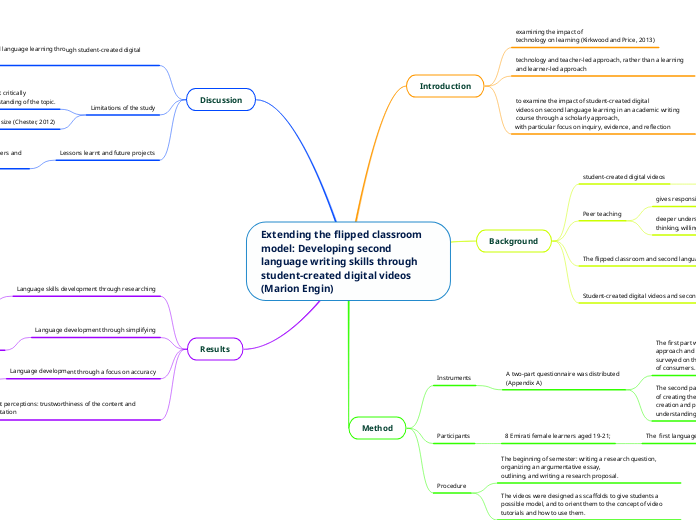Extending the flipped classroom model: Developing second language writing skills through student-created digital videos (Marion Engin)
Introduction
examining the impact of
technology on learning (Kirkwood and Price, 2013)
technology and teacher-led approach, rather than a learning and learner-led approach
to examine the impact of student-created digital
videos on second language learning in an academic writing course through a scholarly approach,
with particular focus on inquiry, evidence, and reflection
evidence- responses of students to the questionnaires and interviews, as well as in the final product of the
videos.
reflection- highlighting some fundamental considerations in the flipped classroom model and peer teaching.
Background
student-created digital videos
develop language and writing skills in a second language
Peer teaching
gives responsibility
deeper understanding of course content, increased critical thinking, willingness to explore, and self-reflection
The flipped classroom and second language learning
A flipped approach is not just a pedagogic model, it is a mindset as to what the teacher and students’ roles are, and how best to support student learning.
Student-created digital videos and second language learning
Beach (2012) outlines how student-created videos developed students’ sense of effective visual communication as a result of audience awareness
Method
Instruments
A two-part questionnaire was distributed
(Appendix A)
The first part was designed to get feedback on the flipped approach and the use of the videos, thus the students were surveyed on their perceptions of the digital videos in their roles of consumers.
The second part aimed to elicit perceptions of the usefulness of creating their digital video and the extent to which the creation and preparation enhanced their own knowledge and understanding of the concepts, as well as their language.
Participants
8 Emirati female learners aged 19-21;
The first language is Arabic, the second language is English
Procedure
The beginning of semester: writing a research question, organizing an argumentative essay,
outlining, and writing a research proposal.
The videos were designed as scaffolds to give students a possible model, and to orient them to the concept of video tutorials and how to use them.
Discussion
Second language learning through student-created digital videos
Much of the research on student-created videos highlight the benefits of students as creators, but do not examine students’ attitudes as consumers to peer-produced videos (Beach, 2012; Kearney
& Schuck, 2006).
Limitations of the study
The videos themselves were not critically
analyzed for evidence of understanding of the topic.
The participant group was a small sample size (Chester, 2012)
Lessons learnt and future projects
The research on the role of students in the flipped
classroom needs to focus on students as both consumers and producers of digital material.
Results
Language skills development through researching
The act of researching a topic, searching for sources,evaluating the information and choosing relevant information helped them to learn the topic better.
Language development through simplifying
The activity of simplifying the information as part of the process. Simplifying the material is a higher-order cognitive skill as it involves summarizing and synthesizing, as well as paraphrasing.
Language development through a focus on accuracy
Language learning through a focus on accuracy of content and language. Audience awareness forced students to be careful in choosing content and appropriate language for explanations.
Student perceptions: trustworthiness of the content and presentation
Working in groups and cooperating on a joint project in terms of the production, many students commented on the quality of the videos in terms of their roles as consumers.
